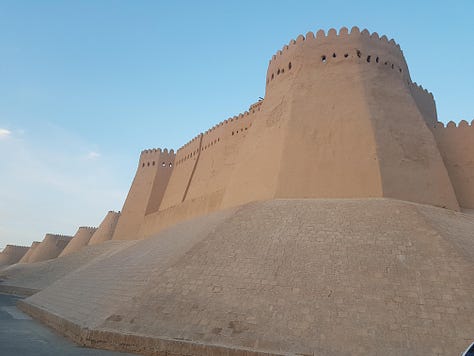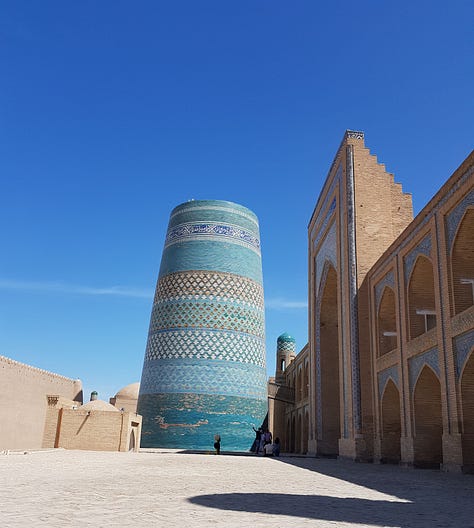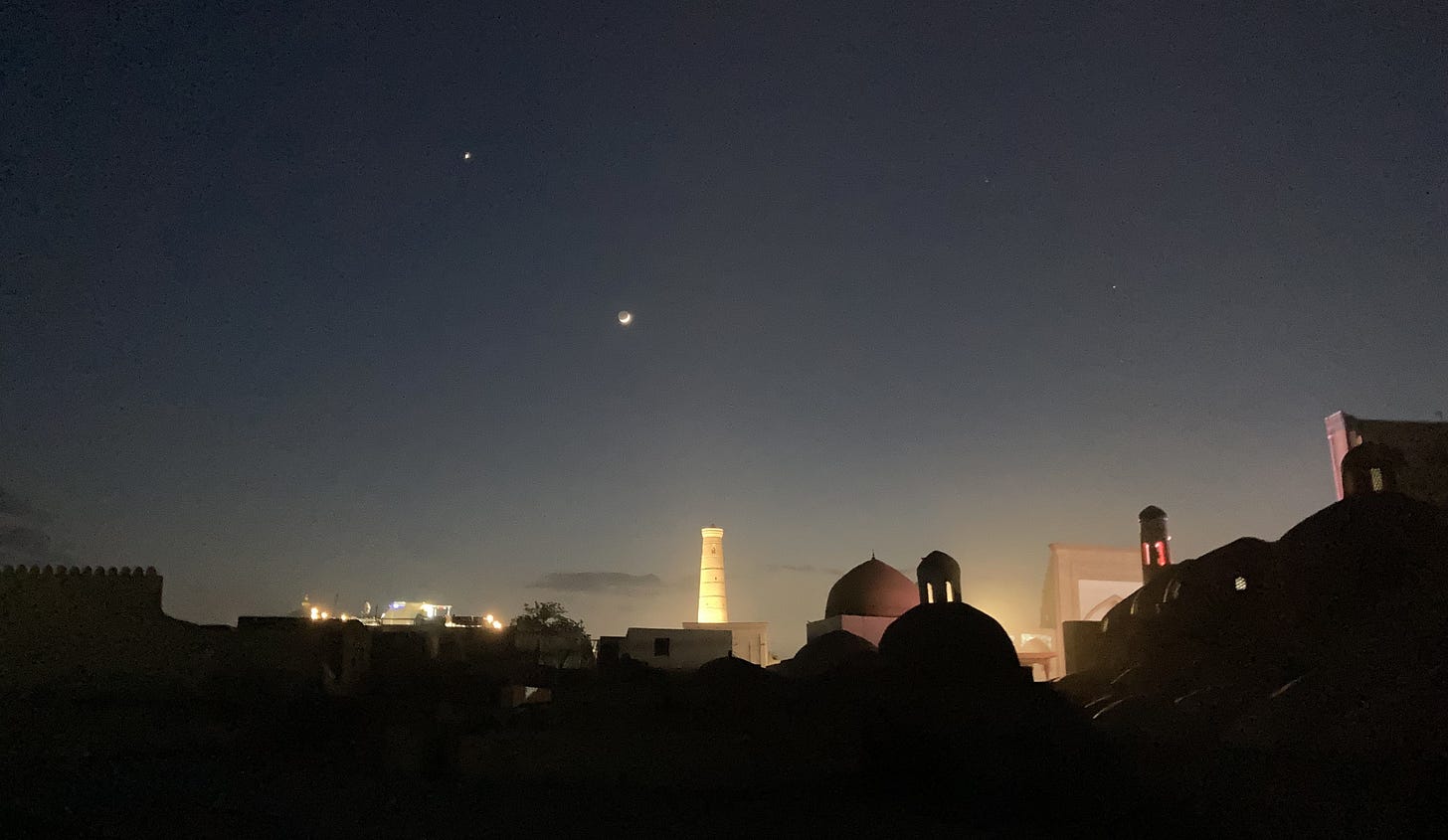We’re catching the midnight train to Khiva, our final destination along the Silk Road. Except that it’s actually the ten past midnight train and we were booked on the previous night. We discover the mistake when we try to board our deluxe, private cabin (Eil’s worth it even if I’m not). The guard is polite about it and suggests we can still buy another two tickets if we’re quick. He points to an office across the other side of the station so we dash off and buy the tickets - open sleepers - then attempt to board again but we still can’t. Why not? What’s wrong now?
Another equally patient guard tells us the train we’re trying to board is going to Tashkent, which is the opposite direction to Khiva. Oh no! Ours must have already left and by now it’s well after midnight and we’re stuck on Khiva station without anywhere to stay or go! But all is not as we think, as the guard explains, our train is behind the one for Tashkent, which moved in front of ours while we were buying the tickets. No problem, he says with a smile, and opens the back door of the Tashkent train, letting us clamber through until we’re reunited with our original Khiva-bound train!
We climb aboard and go looking for our beds. It turns out ‘open sleeper tickets’ mean all the berths are in long, open carriages. People are sprawled over these beds in various states of dishevelled insomnia and don’t look that delighted at being disturbed by us. There’s a bloke on my bed but he moves off when I show him my ticket. I get some sheets from the guard and we make the beds and get in. I’m on the top bunk beside a window that won’t close but at least we’re on a train and, as far as we can tell, en route to Khiva.
I’ve learned, from many years of travelling on sleeper trains, that they’re pretty good as long as you don’t expect to sleep. At best, you’re going to drift in and out of consciousness, listening to the steady rhythm of rail tracks, the snores of fellow passengers and in this case the desert wind rushing through an open window. I enjoy being in this state, scarcely knowing where I am - could be the middle of nowhere or, more accurately, the middle of someone else’s somewhere. Meanwhile, the night passes by and we arrive in Khiva around 7am.
The directions to our guest house say turn left at the third minaret. When we gaze blearily at early morning Khiva, we can see at least a dozen minarets. No problem, I say to Eil, let’s stride off in the direction of town and we’re bound to find it. It could be the lack of sleep that has induced this hallucinatory confidence but twenty lost minutes later, she flags down a taxi, which takes us straight there. Huh!
We’re staying in a small family home - well, the home’s small but the family is extensive as we discover during the time we’re there. The lady who runs the guest house speaks little or no English but summons a sleepy granddaughter to show us our room and explain where to go for breakfast, which is at a table in the courtyard. At different times during our stay, we encounter various grandchildren and their friends - some keen to practise English, while others are shyly taciturn.
Khiva is an important city located in Uzbekistan's Khorezm oasis, inland from the Amu Darya river in a comparatively fertile area. It’s bordered by the Karakum (Black Sand) desert to the south and the Kyzylkum (Red Sand) desert to the north. It’s said the city was founded by Shem, one of Noah’s sons, who woke up after the flood to find himself lost and alone in the burning desert. He dreamt of a city in the shape of a ship, outlined by a vision of flaming torches. The ship-based layout of the city described in this legend can still be seen today in the form of the Ichan-Kala, the historical centre of Khiva protected by formidable mud brick walls up to 10m in height.





Old Khiva is, magnificently and wondrously, built on sand. We sense the desert whenever we enter the walls through the east gate, which is only five minutes walk from our guest house. We taste it in the salty tang of morning as we walk through dusty streets, full of souvenir stalls, tea houses and other tourists exploring mosques, empty palaces, minarets and madrassas. Even in May, the afternoons are hot and sultry so we often retreat to the guest house for a cool nap. When we emerge, the evening air is still warmed by hazy sand while the sun sets quickly behind the city walls. We soon find a favourite spot for watching the sunset - a rooftop restaurant that serves delicious local dishes and cold white wine.
One evening, perhaps still inspired by Muzaffa Abdullaev’s circus painting in Bukhara, we go to watch a trapeze act in the courtyard of an old madrassa. Two brothers and one of their small sons perform in daring ways across a high wire. It’s all exciting stuff but for me the highlight comes when they get together to play a musical finale on drums and those long golden horns we saw in Muzaffa’s painting. It’s as though his work has come to life. The energetic blasts from the horns bring the performance to a resounding close - not a moment too soon for the youngest performer, as you’ll see if you watch this short video clip to the end.
On our final day in Khiva (and on the Silk Road) we climb to the top of the Kuhna Ark (fortress) for a panoramic view of the city. There’s an opinionated Chelsea supporter up there and when he realises I’m English as well, he says words like premiership, flat back four, pre-season training. I try to respond with something deep and meaningful about the Toon but realise my heart isn’t really in it and I just wish he’d go away and leave me to look around and absorb the scene.
Later, over a final sunset drink, I start to wonder if we’ve been away too long - or perhaps not long enough.





I remember my first sleeper train from Hyderabad to Kovalam in India…36 hours or something. Falling asleep to the rhythm of the tracks, you describe it so well! We would wake up and the carriage would be full of men, staring at us. I became skilled at getting changed inside my sleeping bag liner, with an audience!
I love all of Allan's writing but this one was particularly descriptive and I could visualise being there and feeling the excitement, worry and relief. The feelings were real and came to life.